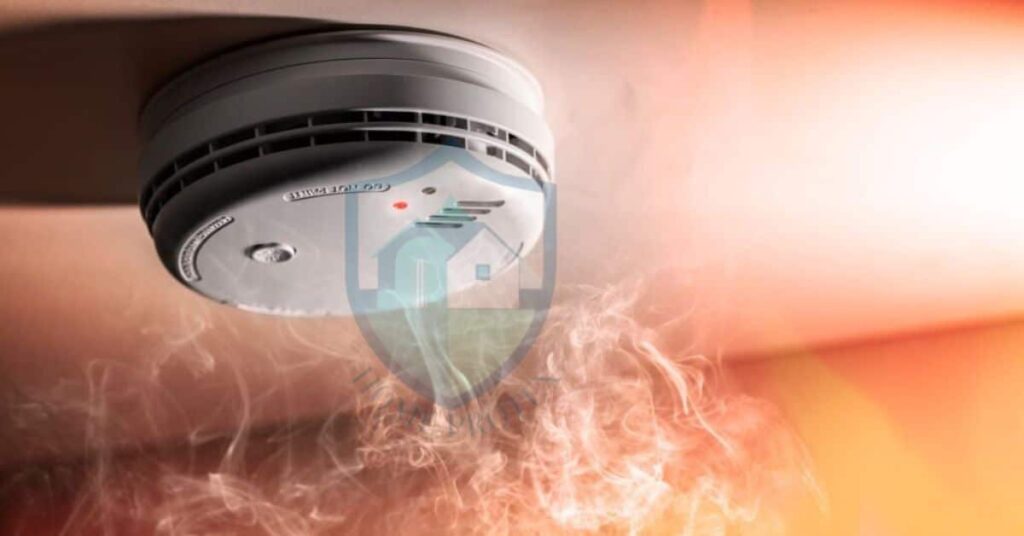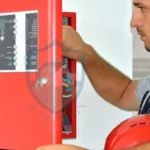Have you ever wondered how does a smoke detector work? Yes, It is a device that detects smoke and alerts people to know the presence of a fire.
As a teen, the loud beeping of the smoke detector once saved my family from a dangerous house fire. My curiosity was sparked to find out – how did that little device detect the smoke so fast and alert us in time?
After researching the science inside smoke detectors, I discovered some fascinating technologies.
In this article, I’ll explain exactly how ionization and photoelectric smoke detectors work to detect particles and sound the alarm that could one day save your life too.
You’ll learn the key components, how smoke disrupts the sensors, the different detection methods, and maintenance tips so your detectors keep you protected.
How Does a Smoke Detector Work?
Overview of Smoke Detector Types
Before digging into the specifics of how smoke detectors work, it helps to understand the two main technologies used:
Ionization smoke detectors are the most common. They use a small amount of radioactive material to detect smoke particles in the air. While ionization detectors react more quickly to flaming, fast-moving fires, they are less responsive to smoldering, smoldering fires.
Photoelectric smoke detectors use a beam of light and a sensor instead of radiation. They detect larger smoke particles from smoldering fires better than ionization models. However, they react a bit slower to fast, flaming fires.
So which is better? Each technology has its strengths and weaknesses. Most experts recommend using both types of detectors for maximum protection. Here’s a quick comparison:
Ionization Smoke Detectors
- Detect smaller smoke particles
- Faster at sensing flaming, fast-moving fires
- Contain a small radioactive source – americium-241
- Prone to more false alarms from cooking smoke, etc.
- Lower cost models
Photoelectric Smoke Detectors
- Detect larger smoke particles
- Better at sensing smoldering, smoldering fires
- Use a light source – no radiation
- Slower reaction to fast, flaming fires
- Less false alarms from cooking, steam, etc.
- More expensive models
Dual sensor detectors combine both technologies for the widest smoke sensitivity. However, standalone ionization and photoelectric models are still very common.
Now that you know the major smoke detector types, let’s examine what’s inside these clever devices and how they actually work to detect fire and alert you and your family.
Inside a Smoke Detector
Smoke detectors may be small, but they contain some sophisticated technology packed inside. The main components of a smoke detector include:
Smoke Chamber – This is the most important part, where the smoke enters and gets detected. Smoke chambers have openings that allow air and smoke to pass through from the surrounding environment.
Sensor – The sensor monitors any change in the smoke chamber and triggers the alarm. In ionization models, this is an electrical circuit. In photoelectric models, it’s an optical sensor.
Light/Radiation Source – The ionization type uses a tiny amount of americium-241 radioactive material. Photoelectric models use an infrared light emitting diode (LED).
Horn – This is the loud 85 decibel siren that sounds when smoke is detected. The horn is essential for alerting occupants.
Power Source – Most detectors use a standard 9V battery. Some are hardwired into the home’s electrical system with battery backup.
Test Button – This button lets you manually test the smoke detector to ensure it’s working properly.
Now that you’re familiar with the components, let’s look at how these pieces work together to detect smoke and sound the familiar alarm.
How Smoke Triggers the Alarm
Smoke detectors constantly monitor the air in the smoke chamber using ionization or photoelectric principles. Here’s what happens when smoke enters:
Ionization – A small radioactive source ionizes the air, allowing current to pass between two electrically charged plates. When smoke enters, the ions attach to the smoke particles. This disrupts the ion flow, reducing the current between the plates. The circuit sensor detects this drop in current and triggers the alarm.
Photoelectric – A light beam shines into the smoke chamber from an LED. When smoke enters, the particles scatter and diffuse the light beam. Less light reaches the optical sensor, activating the alarm circuit.
So in both technologies, smoke causes a change in electrical current or light that the detector circuit interprets as possible fire. The sensor immediately sounds the audible alarm horn to alert occupants of danger.
Ionization models excel at detecting the smallest smoke particles from flaming fires. Photoelectric models work better for detecting large smoke particles from smoldering fires. Using both types offers the broadest smoke sensitivity.
Smoke Detector Ratings and Maintenance
To get the most protection from your smoke detectors, proper installation and regular maintenance are essential. Here are some key guidelines to keep in mind:
Look for reputable third-party ratings – Smoke detectors sold in the U.S. should meet standards and display rating marks from qualified testing labs like Underwriters Laboratories (UL). UL has several classifications for smoke detectors including:
- UL 217 for single station alarms
- UL 268 for commercial detectors
These ratings provide assurance that the products have passed stringent tests for sensitivity, false alarm resistance, shock/vibration and more. Checking for UL or other major lab approval marks is advisable.
Follow all manufacturer instructions – Smoke detector manuals provide specifics on proper installation positioning, wiring, battery replacement, cleaning and testing. Following these instructions helps ensure optimal performance and safety. Improper installation is a major reason for detector failure.
Install interconnected alarms – Interconnected smoke detectors are wired together or communicate wirelessly so that when one unit senses smoke and sounds its alarm, all connected units also trigger. This provides the earliest alert if you’re in a different area of the home.
Test monthly – Smoke detectors should be tested at least once per month to verify they are working correctly. Most units have a “test” button that triggers the alarm when pressed. If no alarm sounds, the battery or unit likely needs replacement.
Change batteries yearly – As a rule of thumb, smoke detector batteries should be replaced yearly. Pick a routine time like when adjusting clocks for daylight savings or a birthday. Smoke alarms will usually emit a short beep every 30-60 seconds when the battery runs low. Failing to replace batteries is the #1 reason smoke alarms don’t work in a fire emergency.
Clean periodically – Dust and debris can interfere with smoke detector operation, especially photoelectric models. Lightly vacuum units every few months to keep them free of dust buildup. Be careful not to damage internal components.
Replace every 8-10 years – The sensor mechanisms in smoke detectors degrade over time. The entire unit should be replaced every 8-10 years at a minimum to ensure safety. Some manufacturers may specify shorter replacement timeframes, which should be followed.
Hire an electrician – If installing a hardwired, interconnected system, hiring a qualified electrician is advised. They can ensure proper home electrical wiring, codes compliance and provide testing.
Frequently Asked Questions
Smoke detectors are vital for home fire safety. But how exactly should they be installed and maintained? Here are answers to some common smoke detector questions.
Can You Put A Camera In A Smoke Detector?
Yes, combination smoke detector/cameras are available. However, these are generally used for home security systems, not as standalone fire safety devices.
The smoke sensing technology in camera combo units may not be as sensitive as standard detectors. Fire officials caution against relying on these for primary smoke detection.
For the best protection, install listed smoke alarms as required by building codes and manufacturer instructions, in addition to any camera systems.
Does A Smoke Detector Work Without Batteries?
Smoke detectors powered solely by batteries will not work if the batteries are missing or dead. However, some smoke alarms are hardwired directly to the home’s electrical system, with battery backup in case of power outage.
Hardwired alarms lacking batteries will still detect smoke and sound an alarm as long as AC power is present. Batteries are required in hardwired units only for detection during power failures.
Where Should A Smoke Detector Be Located?
Experts recommend installing smoke alarms in every bedroom, outside each sleeping area, and on every level of the home, including basements and attics.
Mount at least 4 inches from walls and ceilings. Don’t install near bathrooms, heating appliances, windows or excessively dusty areas.
Dual-sensor units providing both ionization and photoelectric detection are ideal. However, any UL listed alarms positioned per manufacturer guidelines offer critical protection.
How Fast Does A Smoke Detector Work?
Smoke detectors are designed to alarm very quickly at the first signs of smoke. Ionization models typically respond within 30-60 seconds, since they detect very small smoke particles.
Photoelectric detectors react within 60-90 seconds as they look for larger particles. Dual sensor alarms provide maximum speed by combining detection technologies. Fast response times are critical, as fire can spread rapidly once started.
How Long Does A Smoke Detector Work?
The sensing mechanisms in smoke detectors degrade over time. Industry standards require the alarms to function correctly for a minimum of 10 years.
However, some manufacturers specify shorter 7-8 year lifespans. After reaching the age listed in the user manual, the entire smoke detector should be replaced to ensure adequate function. Do not try to prolong service life by disabling alarms. Replace them on schedule with new UL listed units.
What Do Smoke Detectors Actually Detect?
The ionization type detects very small smoke particles, down to 1 micron in size. Photoelectric models detect larger smoke particles around 10 microns.
By sensing disturbances in ionized air or scattered light beams, both alert occupants at the earliest evidence of combustion, before a fire is even visible.
Smoke detectors do not detect heat, flame or gas. Combination smoke/CO detectors are available to also monitor carbon monoxide gas accumulation.
What Happens If You Don’t Have A Smoke Detector?
It’s risky and even illegal not to have working smoke detectors in your home. Smoke spreads rapidly from a fire, moving faster than heat.
Without detectors, you lose vital time to safely exit the building during a fire. Statistics show about 3 out of 5 fire deaths occur in homes without working smoke alarms.
Detectors are required safety devices in residential buildings for good reason – they save lives.
Do You Need A Smoke Detector In The Kitchen?
Due to cooking fumes and steam, fire officials recommend installing photoelectric alarms or dual sensor units in the kitchen instead of ionization detectors.
Photoelectric models resist false alarms from cooking particles better. If using ionization detectors near the kitchen, mount them at least 10 feet away from cooking appliances to help avoid nuisance activation.
Any smoke detector is better than none, as long as the type and location accounts for cooking environments.
Smoke detectors provide a crucial first alarm in the event of a dangerous home fire. Following placement guidelines carefully, testing detectors monthly, replacing them on schedule, and using the right type for each location will offer your family the very best protection.
Conclusion
As you can see, smoke detectors utilize ingenious ionization and photoelectric principles to detect fire particles in the air and sound a potentially life-saving alarm.
While the technologies inside these devices are sophisticated, taking a few basic maintenance steps like testing frequently, changing batteries, and periodic cleaning will keep them working reliably.
Installing interconnected units and replacing detectors every 8-10 years provides an extra margin of safety. By understanding what’s inside your home’s smoke detectors and how to care for them, you can have peace of mind knowing your family has an early warning should fire ever strike.




